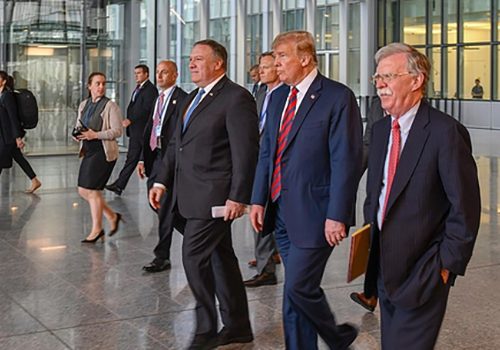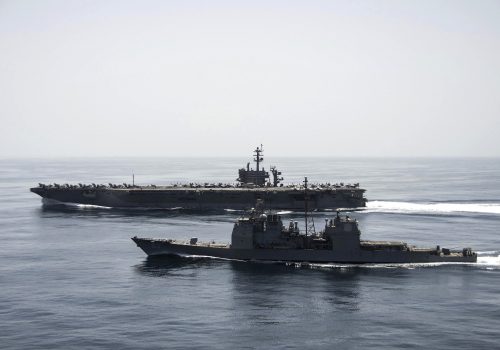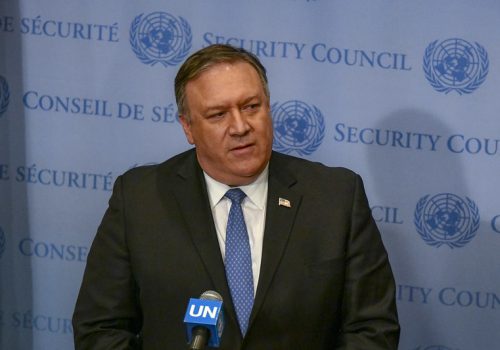The ‘maximum pressure’ campaign undermines Trump’s national security strategy
Americans should not be surprised that we almost went to war with Iran in January. Military escalation is the logical outcome of a US “maximum pressure” campaign that, by steadily squeezing the Iranian economy and providing no viable diplomatic off-ramps, incentivizes Tehran to fight back. In the process, we continually impose upon ourselves the dilemma of responding to Iranian aggression with restraint, potentially encouraging bolder acts of defiance, or upping the ante in order to “restore deterrence.”
This cycle of escalation is counterproductive to US President Donald Trump’s own National Defense Strategy (NDS) of prioritizing great power competition with China and Russia—one of the few Trump visions for America that democrats and republicans generally support. If the United States is serious when it asserts that “Long-term strategic competitions with China and Russia are the principal priorities,” then the Trump administration must reevaluate its policy of maximum pressure toward Iran.
The US maximum pressure campaign seeks to squeeze the Iranian economy on the theory that crippling sanctions will force Tehran to choose between its own economic viability and its destabilizing activities around the region. In 2018, the Trump administration withdrew from the Joint Comprehensive Plan of Action (JCPOA), and issued a list of 12 demands that are as desirable as they are unrealistic. The United States would certainly be better off if Iran withdrew its forces from Syria and discontinued support for proxy militias in Iraq, Lebanon, and Yemen, but we have seen no progress on these fronts to date and most experts agree that Tehran is unlikely to concede on these points despite the economic pain from sanctions.
In fact, Iran has every incentive to defy US pressure. Research has shown that sanctions against a target that expects continued conflict are unlikely to produce significant concessions. Under such conditions, a target is likely to fear that giving in today will lead to more pressure tomorrow and therefore resist at almost any cost. The flaw in the logic of the maximum pressure campaign then is not that Iran does not deserve to be punished, but rather that an exclusively punitive policy unaccompanied by diplomatic off-ramps incentivizes Tehran to fight fire with fire by imposing costs on its perceived aggressors.
This is precisely what we have seen to date. When the Trump administration ended sanctions exemptions for countries purchasing Iranian oil in May 2019, threatening Iran’s economic lifeline, Tehran responded by attacking oil tankers carrying Saudi and Emirati crude. If Iran couldn’t freely trade its oil, then neither would its rivals. In June 2019, the Iranians shot down a US drone in the Straits of Hormuz, prompting the White House to order a retaliatory strike that President Trump publicly acknowledged calling off only at the last minute.
The United States next reacted by starting to build an international coalition that could monitor and deter threats to the free flow of regional maritime commerce. In September 2019, Iran lobbed missiles at Saudi oil processing facilities, causing a significant temporary shutdown is Saudi oil production.
This is the road to conflict that would eventually culminate in the January 3 strike on Major General Qasem Soleimani. Maximum pressure may be having its desired impact on the Iranian economy, but it has so far yielded no diplomatic breakthroughs and far too much needless violence, all the while prompting the United States to pour more resources into the Middle East at the expense of other theaters.
Since tensions began to rise last May, the US military has deployed more than 17,000 troops to the Persian Gulf region, along with aircraft, missile defense batteries, warships, and other assets, according to the US Department of Defense. These are finite military resources—every day spent operating in the Middle East is one less day training for long-term strategic competition with China and Russia.
Take for example the USS Abraham Lincoln aircraft carrier’s recent record-breaking deployment. The Lincoln was conducting exercises in European waters during May 2019 when it was diverted to the Middle East in response to rising tensions. It was then extended in the region for a number of months, and by the time it returned to port in January, the Lincoln had earned the distinction of the longest post-Vietnam era deployment. If US military commanders in Europe or Asia had plans for these ships, the maximum pressure campaign ensured that they would need to look elsewhere.
It is also difficult to reconcile the maximum pressure campaign with our stated strategic goal of strengthening American alliances and attracting new partners. Our European partners in negotiating the JCPOA—Britain, France, and Germany—vigorously opposed our withdrawal from that deal and continue to oppose maximum pressure. Many of the states hurt most by our May 2019 cancellation of sanctions waivers are US treaty allies in East Asia. As of today, only seven nations have joined the International Maritime Security Construct that the United States started building last summer to secure commercial shipping in the Persian Gulf.
If, as the NDS states, “the willingness of rivals to abandon aggression will depend on their perception of US strength and the vitality of our alliances and partnerships,” then the maximum pressure campaign is likely to be viewed quite positively in Moscow and Beijing.
This takes us back to Major General Soleimani. In executing the strike and simultaneously threatening massive retaliation “if Iran strikes any Americans,” the United States ceded to Tehran a significant measure of influence over the course of future events.
Surely there is no longer any question that Iran’s January 8 missile barrage on Iraqi bases hosting US forces could easily have killed US troops. We now know that more than 100 service members have been treated for traumatic brain injuries, and Chairman of the Joint Chiefs of Staff General Mark Milley has publicly shared his view that the attack was intended to kill personnel.
And what if it had? What types of responses, resources, and commitments would have been required of the United States in that entirely possible scenario? Based on the pattern over the past year, we can be confident that every step up the escalatory ladder with Iran will lead to greater US distraction from our so-called strategic priority of great power competition.
For now, however, the United States has managed to retain control over its Iran policy. We should use that control to start preparing viable diplomatic off-ramps from the current cycle of escalation—to negotiate on terms less ambitious than the current demands but perhaps just better enough than the JCPOA to plausibly declare victory. Even that is a long shot, as Iran has little reason to talk with the Trump administration before the November 2020 election, and we may still see more retaliation for the Soleimani strike. Still, the administration should start messaging now that if President Trump wins a second term he will pair his pressure with a willingness to negotiate on more realistic terms.
One former Trump advisor reminded us on January 24 that many “maximum pressure” options remain available. That is the administration’s prerogative, but we have seen the unambiguous costs of pressure for pressure’s sake alone. In order to stay focused on our long-term priorities, the US government must align its Iran policy with its national security strategy.
David Wallsh is a defense analyst in Washington who has advised various US commands on the Middle East. From 2013 – 2016, he served as an advisor on Middle East security in the Office of the Secretary of Defense for Policy. The views expressed are his alone.
Image: A MH-60S Sea Hawk helicopter lifts off from the flight deck of the aircraft carrier USS Abraham Lincoln as it transits the Strait of Hormuz off Oman (Reuters)


